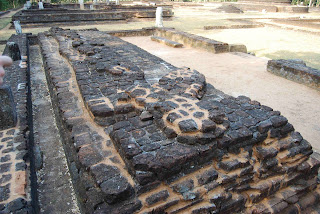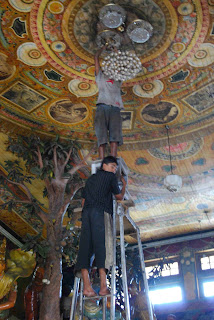
Our late afternoon/early evening field trip took us to one of Jayantha's nearby coconut groves. An interesting fact about coconuts - everything associated with the coconut is useful. Like tea, coconuts are plucked. A coconut plucker will pluck about 500 trees per day. A tree in its prime will produce 10-12 coconuts per pluck. The coconuts are then aged/dried for about 2 months in a 3'-deep heap covered with coconut fronds. The coconuts are then husked to reveal the nut inside. The discarded husk is used to make rope or charcoal. The nut is what we get from the grocery store when we buy what we call a "whole coconut." Nuts not sold in this manner are further processed. The nut is broken open and sun-dried for one day and then kiln-dried for three days. The dried product inside the shell is called copra; which is sold to mills where it is pressed into coconut oil. The cake remaining after pressing is called poonac and is used for animal feed. The shell that housed the copra is burnt to make charcoal.
Some other coconuts facts:
- Sri Lanka produces three billion coconuts per year and two-thirds of those are consumed internally.
- A coconut tree takes 4 to 6 years to mature. It will live for up to 100 years, but its useful productive life is about 80 years.
- An acre of land will support about 70 coconut trees.

















































